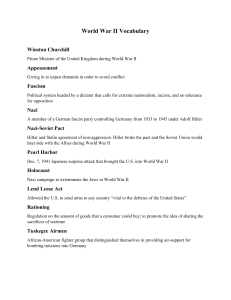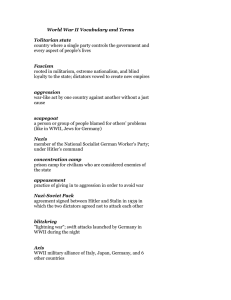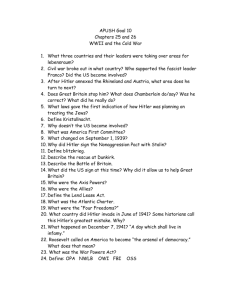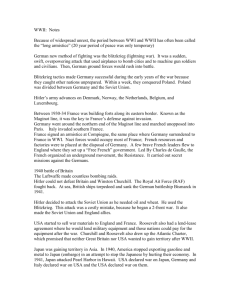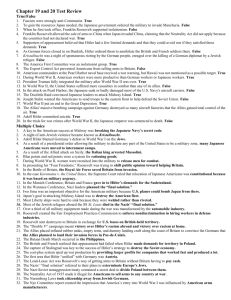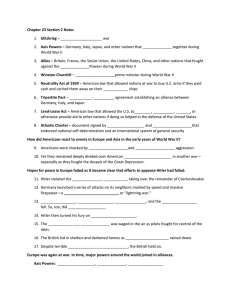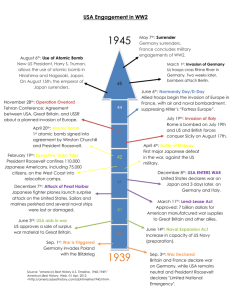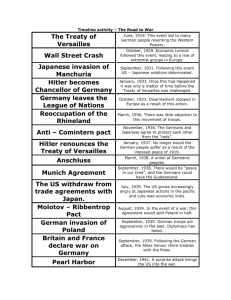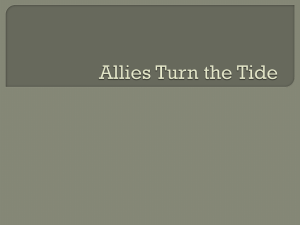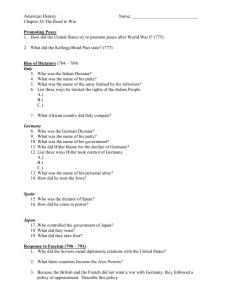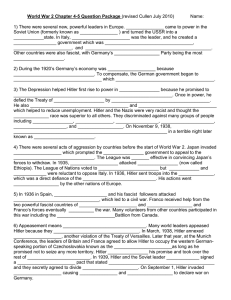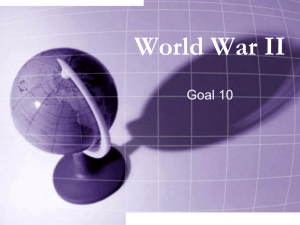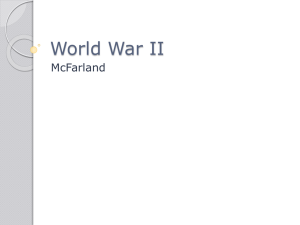Ch. 8 Lesson 1: “WORLD WAR II BEGINS” 5
advertisement
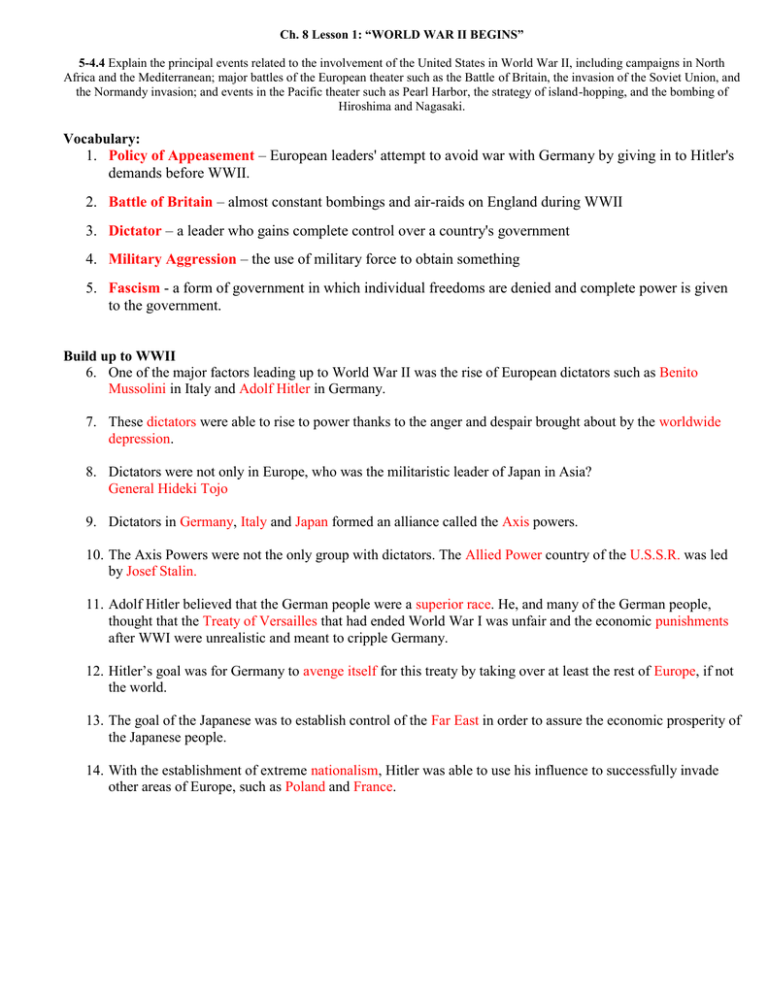
Ch. 8 Lesson 1: “WORLD WAR II BEGINS” 5-4.4 Explain the principal events related to the involvement of the United States in World War II, including campaigns in North Africa and the Mediterranean; major battles of the European theater such as the Battle of Britain, the invasion of the Soviet Union, and the Normandy invasion; and events in the Pacific theater such as Pearl Harbor, the strategy of island-hopping, and the bombing of Hiroshima and Nagasaki. Vocabulary: 1. Policy of Appeasement – European leaders' attempt to avoid war with Germany by giving in to Hitler's demands before WWII. 2. Battle of Britain – almost constant bombings and air-raids on England during WWII 3. Dictator – a leader who gains complete control over a country's government 4. Military Aggression – the use of military force to obtain something 5. Fascism - a form of government in which individual freedoms are denied and complete power is given to the government. Build up to WWII 6. One of the major factors leading up to World War II was the rise of European dictators such as Benito Mussolini in Italy and Adolf Hitler in Germany. 7. These dictators were able to rise to power thanks to the anger and despair brought about by the worldwide depression. 8. Dictators were not only in Europe, who was the militaristic leader of Japan in Asia? General Hideki Tojo 9. Dictators in Germany, Italy and Japan formed an alliance called the Axis powers. 10. The Axis Powers were not the only group with dictators. The Allied Power country of the U.S.S.R. was led by Josef Stalin. 11. Adolf Hitler believed that the German people were a superior race. He, and many of the German people, thought that the Treaty of Versailles that had ended World War I was unfair and the economic punishments after WWI were unrealistic and meant to cripple Germany. 12. Hitler’s goal was for Germany to avenge itself for this treaty by taking over at least the rest of Europe, if not the world. 13. The goal of the Japanese was to establish control of the Far East in order to assure the economic prosperity of the Japanese people. 14. With the establishment of extreme nationalism, Hitler was able to use his influence to successfully invade other areas of Europe, such as Poland and France. 15. Fill in the chart by matching the leader to the country they represented. Country Leader Germany *________________________ Great Britain *________________________ *________________________ Franklin Roosevelt *________________________ Josef Stalin *________________________ Benito Mussolini Japan *________________________ The Start of WWII 16. At first, the European leaders tried to avoid war and responded to Hitler’s aggression with the policy of appeasement, giving in to his demands. 17. However, when Germany invaded Poland, allies Britain and France declared war on Germany. Soon Germany had defeated France and was constantly bombing Great Britain in an effort to break the spirit of the last undefeated European country. 18. These continuous air raids were known as the Battle of Britain and they were significant because they were the first instance in which Hitler’s plans of conquest were foiled. 19. Germany also invaded the Union of Soviet Socialist Republics (U.S.S.R.) even though they had promised to avoid fighting each other. 20. The Congress of the United States had passed laws known as the Neutrality Acts that required President Roosevelt to maintain an official policy of neutrality. However, President Roosevelt tried to help the Allies with supplies. 21. After the Japanese bombing of the U.S. Pacific fleet at Pearl Harbor, Hawaii, President Roosevelt asked the United States Congress to declare war on Japan. 22. Germany and Italy then declared war on the United States in order to support their ally, Japan. The United States joined with Great Britain and the Soviet Union became known as the Allied Powers or the Allies. 23. The goal of the Allies was to stop the Axis Powers and defeat them unconditionally so that they could not invade other countries again. 24. The American strategy in Europe included heavy bombing raids on Germany and landing ground troops on the edges of German occupied lands. 25. The Allied invasion of North Africa was known as Operation Torch. 26. The Allies landed in North Africa hoping to: - free the Mediterranean Sea from German control - protect the oil fields of the Middle East - take some of the pressure off of the USSR 27. The USSR was able to hold off the German advance and then began defeating them on the eastern front. 28. Allied landings in Italy brought the surrender of the Italians but German forces continued the bitter fight on the Italian peninsula. 29. The invasion of Normandy on D-Day provided a second front against the Germans on the western front and provided some relief for the Russian troops. 30. The invasion of Normandy led to the eventual surrender of the Axis Powers in Europe, but the Allied powers continued to struggle against a Japanese army that was determined to fight until all was lost. The Pacific Theater 31. The purpose of the island-hopping strategy in the Pacific theater was to take only strategic Japanese-held islands in order to move within range of the gasoline tank capacity of American planes so that they could bomb Japan. Why did the Americans want to bomb Japan? To prepare it for a land invasion of the Japanese home islands. 32. The Americans had heavy casualties as they fought to take Japanese-occupied islands because of the Japanese unwillingness to accept defeat. 33. An ailing President Roosevelt died and Vice-President Harry S. Truman was sworn in as President. 34. As the preparations for the invasion of Japan continued, scientists successfully tested the world’s first atomic bomb. 35. What was the tough decision faced by President Truman? Whether to risk many more American lives with an invasion of Japan or to use the atomic bombs. 36. The United States dropped two bombs, one on Hiroshima and a second on Nagasaki, which led to the surrender of the Japanese and brought about the end of World War II.
